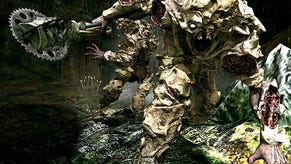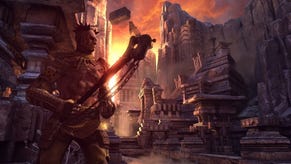Rage
The first two hours.
Rage begins in outer space. There's a meteor floating slowly towards the Earth at thousands of miles per second, it's going to smash everything to pieces and everyone's going to die. You get to watch it scattering dust in Saturn's rings and glancing off the moon as it travels inexorably towards us – and the start of another post-apocalyptic first-person shooter.
For me though, Rage began exactly four years ago. On 2nd August 2007 I was sitting in the audience at QuakeCon when id Software announced the identity of its next proper game after Doom 3. It was going to be a first-person shooter but it was also going to have driving bits, and it was called Rage.
Back then the developer's fans – myself included – were broadly excited, but also privately concerned that this new racer-shooter hybrid might not be a proper id game. Proper id games are about fidelity in control, extreme violence, and ingeniously designed levels packed with fierce monsters. First and foremost they are proudly corridor-driven first-person shooters.
Rage certainly doesn't feel like that when it starts. 106 years after the meteor hits Earth you wake up from your cryogenic sleep to the sound of sirens. The other stasis pods in your "Ark" are now coffins, their occupants mummified by years of malfunction. As you stumble outside and your vision clears, you peer out into a world you don't recognise and wonder what to expect.
A bit like Fallout 3, your first view of the big outdoors is bright and yet gloomy at the same time. Your Ark is buried high up the side of some sort of quarry, staring out over mountains of rubble, abandoned tower cranes and industrial decay under the baking rays of a sun the world can finally see again.
Within seconds of getting your bearings, though, you're caught up in a fight between some local bandits and another leftover human called Dan Hagar, who rescues you and whisks you away in his dune buggy.
He doesn't really explain why he's rescued you, but as he drives you back to a ramshackle old gas station and auto shop that he shares with a few other survivors – coasting past bandit patrols performing executions at the side of the road along the way, and peering at you over the top of his green-tinted sci-fi sunglasses – he talks about the bad guys who jumped you and alludes to a scary controlling force called the Authority who pay big money for chumps like you who stumble out of Arks.
Hagar quickly gives you something to do. The bandits who he interrupted to save you are based nearby, and once they realise he intervened and killed their friends they will soon head down the hill and turn Hagar's little corner of the post-apocalypse into something a little bit more Apocalypse Now. It's up to you to go and do something about them, so you head to Hagar's garage, borrow an ATV (that's a quad bike in old money) and start following the breadcrumb trail on your mini-map to your objective.
It's a slow burn of an opening. Even 90 minutes later, when you reach the first big hub town of Wellspring – itself not much more than a rickety corrugated village planted on top of a rare source of water – you still know very little about the hostile forces that justify the local mayor's paranoia about your Ark origins and the heavily fortified 30-foot reinforced steel barricades that control people coming and going.














